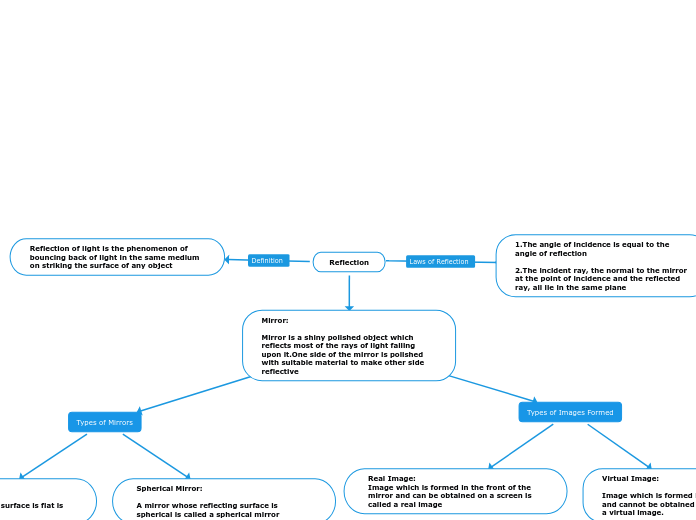
Types of Images Formed
Real Image:
Image which is formed in the front of the mirror and can be obtained on a screen is called a real image
Virtual Image:
Image which is formed behind the mirror and cannot be obtained on a screen is called a virtual image.
Types of Mirrors
Plane Mirror:
A mirror whose reflecting surface is flat is called a plane mirror.
Properties:
1.Image formed is virtual and erect
2.The size of the image is equal to that of the object
3.Image formed is as far behind the mirror as far the object is in front of it
4.Image formed is laterally inverted
Spherical Mirror:
A mirror whose reflecting surface is spherical is called a spherical mirror
Concave Mirror:
A spherical mirror whose reflecting surface is curved inwards, that is, faces towards the centre of the sphere is called a concave mirror
Converging Mirror
Image Formation
1.At Infinity
Characteristics of image formation:
1.Real and Inverted
2.Highly diminished(point sized)
3.At F
2.Beyond C
Characteristics of image formation:
1.Real and Inverted
2.Diminished
3.Between F and C
3.At C
Characteristics of image formation:
1.Real and Inverted
2.Same size
3.At C
4.Between C & F
Characteristics of image formation:
1.Real and Inverted
2.Enlarged
3.Beyond C
5.At F
Characteristics of image formation:
1.Real and Inverted
2.Highly Enlarged
3.At infinity
6.Between P & F
Characteristics of image formation:
1.Virtual and erect
2.Enlarged
3.Behind the Mirror
Uses:
Concave mirrors are commonly used in torches, search-lights and
vehicles headlights to get powerful parallel beams of light. They are
often used as shaving mirrors to see a larger image of the face. The
dentists use concave mirrors to see large images of the teeth of patients.
Large concave mirrors are used to concentrate sunlight to produce
heat in solar furnaces.
Convex Mirror:
A spherical mirror whose reflecting surface is curved outwards is called a convex mirror
Diverging Mirror
Image Formation
1.At infinity
Characteristics of image formation:
1.Virtual and Erect
2.Highly diminished(point sized)
3.At F
2.Between P and Infinity
Characteristics of image formation:
1.Virtual and Erect
2.Diminished
3.Between P and F
Uses:
They are used in rear-view mirrors in vehicles.They are fitted on the side of the vehicle for the driver to see the traffic behind him/her to facilitate safe driving.Convex mirrors are preferred because they always give an erect, though, diminished image also they have a wider field of view as they are curved outwards thus convex mirrors enable the driver to view much larger area than would be possible with a plane mirror
Terms used:
Pole(P):The centre of the reflecting surface of a spherical mirror is a point called the pole. It lies on the surface of the mirror.
Centre of Curvature(C):The Reflecting surface of a spherical mirror forms a part of the sphere.This sphere has a Centre.This point is called the centre of the curvature of the spherical mirror.
Radius(R):The radius of the sphere of which the reflecting surface of a spherical mirror forms a part is called the radius of the curvature of the mirror.
Principal Axis(P):Imagine a straight line passing through the pole and the centre of curvature of a spherical mirror.This line is called the principal axis and the principal axis is normal to the mirror at its pole
Principal focus(F): The reflected rays appear to come from a point on the on the principal axis. This point is called the principal focus of the convex mirror, whereas in the case of concave mirror the reflected rays are all meeting/intersecting at a point on the principal axis of the mirror.This point is called the principal focus of the concave mirror.
Focal Length(f): The distance between the pole and the principal focus of a spherical mirror is called the focal length.
u(object distance)
Concave: -ve always
Convex: -ve always
f(focal length)
Concave: -ve always
Convex: +ve always
hi(height of image)
Concave: -ve for real images
+ve for Virtual images
Convex: +ve always
v(image distance)
Concave: -ve for real images
+ve for virtual images
Convex: +ve always
ho(height of object)
Concave: +ve always
Convex: +ve always